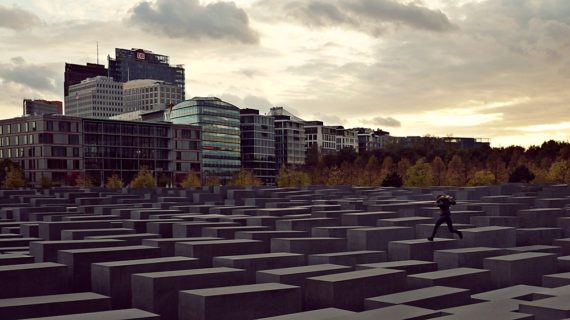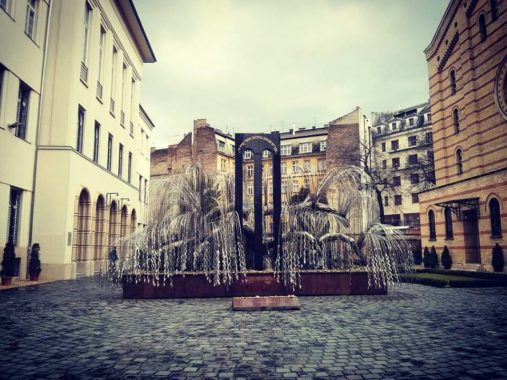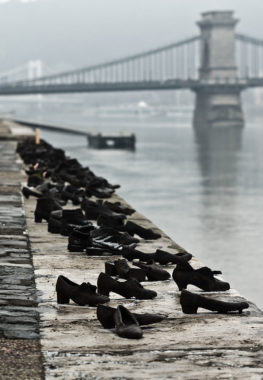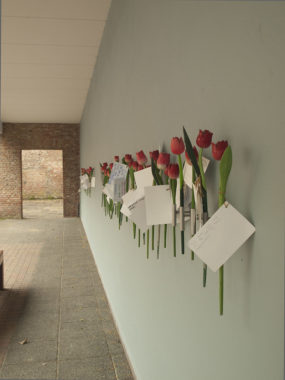There are hundreds of Holocaust memorials around the world, including many in cities where we run walking tours. We sat down with scholars in Berlin, Budapest, and Amsterdam to learn more about some of the most significant Holocaust memorials around the world, and to get their insight into some of the trickier aspects of interpretation and memorialization.

Memorial to the Murdered Jews of Europe in Berlin
Once you’ve interacted with Berlin’s “Holocaust memorial”, as it’s commonly known, you won’t forget it. Conceived by American architect Peter Eisenman, the site is a Field of Stelae, a sprawling network of 2711 upright stone slabs–all grey, and of varying sizes and angles, in the heart of Berlin’s tourist district a few steps from the Brandenburg Gate.
“The effect when walking through the monument, which descends into a valley in which the stelae are at their tallest, is quite staggering,” says Context docent Finn Ballard, one of the scholars who leads our Jewish Berlin tour. “The memorial engages on a visceral level, inciting feelings of bewilderment, entrapment, isolation, dizziness, claustrophobia.”
Walking between the pillars and descending the overall depth of the monument, as visitors are encouraged to, it’s difficult not to feel awed and slightly uncomfortable. Though many have drawn comparisons with a cemetery, Eisenman’s intention was to keep the design purposefully abstract. The number of stelae is arbitrary, and the architect wanted to convey an ordered system that “has lost touch with human reason”; a labyrinth of uncertainty.
Construction of the memorial began in 2000, but its history stretches back decades into the 20th century. An idea was first floated in the 1980s by a small group of German citizens who saw a need to acknowledge the lives and deaths of the six million Jewish people who were murdered by the Germans during the Holocaust. The campaign gathered momentum and in 1994, the government announced a competition. After a failed round of submissions and judgements that ultimately dissatisfied then chancellor Helmut Kohl, Eisenman’s design was selected as the winner of a second contest.
From the government’s perspective, the monument was built “to honor the murdered victims, keep alive the memory of…inconceivable events in German history and admonish all future generations never again to violate human rights, to defend the democratic constitutional state at all times, to secure equality before the law for all people and to resist all forms of dictatorship and regimes based on violence” (Bundestag Resolution 1999, via Humanity in Action).
Officially, the monument is called the Memorial to the Murdered Jews of Europe, and it is considered one of the most significant and high profile Holocaust memorials around the world. Some have criticized the passive language, which identifies the victims but not the perpetrators. Others have countered that that’s exactly the point–the answer is so obvious as to not require further explanation. “Eisenman’s work has courted much controversy,” explains Finn, “with some critiques of the monument focusing on the behaviour of visitors, for whom the artist has built a photogenic structure which is used by some as a playground.”
Yet anyone who has spent time exploring Berlin’s layers of history will understand how the country, through its pockmarked capital, is doing an impressive job of being present with the uneasy weight of its past.
“Although it’s a contentious sculpture, I find it a resounding success as a memorial – but to experience its full effect, it’s really necessary to visit the underground Information Center as well,” concludes Finn. This small space beneath the monument is continually commented on by our clients and docents alike to be one of the most moving and excellent exhibitions in the city.
The memorial is visited during our “Story of Berlin” Sightseeing Tour of Berlin and Nazi Berlin Tour, as well as our Jewish Berlin tour, and can be included as part of a custom private tour of Berlin.
Dohany Street Synagogue Holocaust Memorial and Shoes on the Danube Bank in Budapest
Budapest, with its thriving contemporary Jewish culture, has several Holocaust memorials. One was set up by a community itself, in a closed space and through mostly Jewish funding. The other was set up by non-Jewish Budapest intellectuals, in a public space via independent funding. One is dedicated to all victims of the Holocaust, the other for victims of a specific type of persecution by a specific group of people. One does not mention perpetrators, the other one specifically mentions those to be blamed. “I think both are very moving and very symbolic memorials,” says Context docent and Jewish expert Szonja Komoroczy, one of several scholars who lead our Jewish Quarter of Budapest tour. “Both are successful and respectable in their own form and with their own goals, and they complement each other extraordinarily.”

The Holocaust Memorial in the garden of the Great Synagogue on Dohany Street memorializes the Holocaust for the Jewish community. “For me, the most interesting elements are the spontaneous original tombstones from the graveyard in the synagogue garden, now replaced by uniform tombstones,” explains Szonja. The original tombstones are on the wall at the back of the garden. Soon after the liberation of the ghetto and the burial of the corpses here, people started to light memorial candles for their lost ones, then put up plaques and tombstones – mostly for those who died in the ghetto, but eventually also for anyone else who did not have a memorial elsewhere. “The Jewish Archive and Museum has been working on identifying who actually is buried there – and now they have their uniform tombstones, the spontaneous ones were kept and moved to the back of the garden, the side of the synagogue,” she adds.
The weeping willow part of the memorial is probably its most famous. “It’s beautifully designed,” says Szonja, “with the two stone tablets ‘emptied out’, the branches of the willow showing an upside down menorah, the leaves of the willow crying in the wind, and the moving talmudic statement about the person who saves one life saving the entire world.”

photo by Nikodem Nijaki via Wikipedia
Shoes on the Danube Bank is a memorial that honors the Jews who were killed by fascist political militia in Budapest during World War II and is one of the more conceptual Holocaust memorials around the world. Conceived by film director Can Togay and sculptor Gyula Pauer, the rows of empty shoes–iron yet detailed and lifelike–were installed in 2005. The memorial pays tribute to the lives lost under Hungary’s Arrow Cross party, which shared many ideologies with Germany’s Nazis, including a particularly violent anti semitism, and took to the streets to shoot Jews during 1944 and 1945.
“The shoes are very touching in their simplicity: This was the scene that Budapest residents woke up to on various locations along the Danube embarkment after a night of violence.” says Szonja. “It shows the void, that something is missing, something is terribly wrong. It is a beautiful initiative and effort of non-Jews, civilians, and locals trying to commemorate, to face, to understand a shameful part of their history, of the common history of the city. To show guilt as well as emptiness.”
Explore the Dohany Street Synagogue on our Jewish Quarter tour or Hungarian Jewish Food Tour. The Shoes on the Danube Bank can be visited during our Introduction to Budapest Walking Tour and custom tour of Budapest.
National Holocaust Memorial in Amsterdam
Amsterdam’s National Holocaust Memorial is part of the city’s Jewish Cultural Quarter, which today also comprises the Portuguese Synagogue and Jewish Historical Museum and is the last o the Holocaust memorials around the world that we’ll look at.
Until 1940, what is now the Hollandsche Schouwburg was a popular theater, but in 1941 the Nazis, who were then occupying the city, changed its name to the Joodsche Schouwburg– Jewish Theatre. Initially, it became the only theater Jews were allowed to act in or attend, but over the years it took on an even more sinister role.

Amsterdam; photo by Juliane H. via Wikipedia
“It was also used as the holding centre for the Jews of Amsterdam prior to them being sent to the Westerbork Camp (the transit camp for Dutch Jews. From Westerbork people were sent to the concentration camps of Central and Eastern Europe),” explains Context docent and expert Michael Karabinos.
After the war ended, authorities initially wanted to revive the Hollandsche Schouwburg to its former use as a people’s theater, but the attempt was met by strong protest. In 1947, the Hollandsche Schouwburg Committee took possession of the building and in 1962 the city council installed a monument in remembrance of the Jewish victims of Nazi terror.
Later, in 1993 a memorial room was added, which included a list of the 6700 family names 104,000 Dutch Jews murdered in the war. “It’s a room meant for reflection and recollection,” explains Michael. The space is meant for survivors and relatives of those who perished, who have no grave.
Explore Amsterdam’s Jewish Cultural Quarter with Michael or another of our local experts during our Jewish Amsterdam tour.

